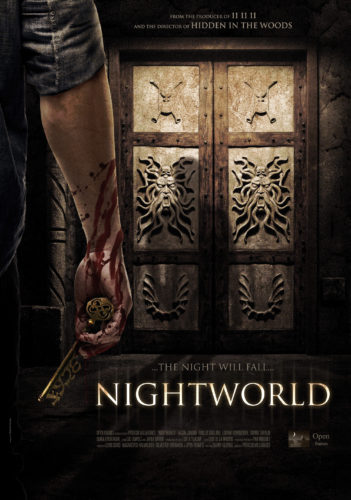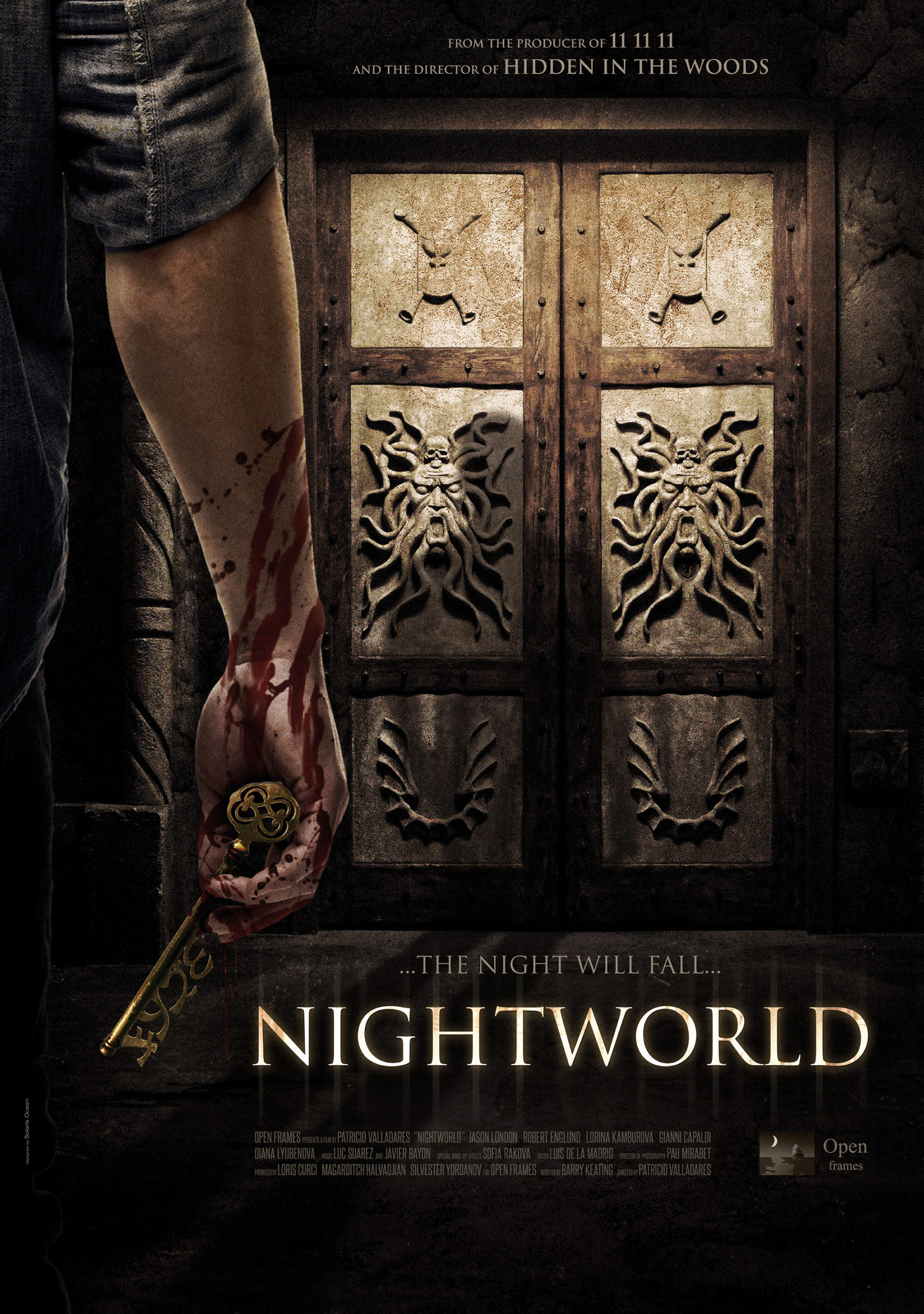 Nightworld (2017) – I’m always a sucker for intriguing, mysterious premise: In this case, former police officer Brett is hired to watch the surveillance cameras somewhere behind the sealed door in the basement of an historic Bulgarian apartment building. What’s he supposed to look for? Anything. What’s he supposed to do? Call this number. Any more details? No.
Nightworld (2017) – I’m always a sucker for intriguing, mysterious premise: In this case, former police officer Brett is hired to watch the surveillance cameras somewhere behind the sealed door in the basement of an historic Bulgarian apartment building. What’s he supposed to look for? Anything. What’s he supposed to do? Call this number. Any more details? No.
Unfortunately, as with many of these intriguing premises, the story that builds on it refuses to make sense. Robert Englund co-stars as the blind guy who used to have Brett’s job, and who he’s supposed to call it he sees anything. Um… the blind guy can’t come and look at the tapes, he can only say, “Tell me what you see.” And yet, the blind guy seems to be the most capable person of any of the mysterious people guarding this [spoiler] gateway to the “other side,” which is in danger of releasing the dead to overrun the world of the living because an ancient guy whose life is linked to it is close to death… So maybe there ought to be more resources deployed here than a single ex-cop that they don’t tell about any of this? I guess they thought that the intrigue of the initial premise would carry the audience through the spackled-over story problems to come. It doesn’t.
 Fist of Fury (1972) – Bruce Lee singlehandedly dishes out payback for the indignities caused by the Japanese during the occupation of Shanghai. There are a huge bunch of beat-downs wherein Bruce demonstrates how much better kung fu is than karate, especially the much-video-clipped nunchuck battles. Not a lot of what you would call “nuance,” but nuance doesn’t hold up to a boot to the head.
Fist of Fury (1972) – Bruce Lee singlehandedly dishes out payback for the indignities caused by the Japanese during the occupation of Shanghai. There are a huge bunch of beat-downs wherein Bruce demonstrates how much better kung fu is than karate, especially the much-video-clipped nunchuck battles. Not a lot of what you would call “nuance,” but nuance doesn’t hold up to a boot to the head.
 When Taekwondo Strikes (1973) – But in case you thought there was too much moral ambiguity in Fist of Fury, When Taekwondo Strikes takes the anti-Japanese sentiment to a whole ‘nother level. This time, it’s Koreans against the occupying Japanese; a leader of the resistance, staying undercover at a Christian church run by an American priest and his niece, is discovered and has to run around Korea and eventually into China, with the Japanese hot on his tale. It’s not unexpected that one of the main good guys is an ethnic Chinese (Angela Mao) who recognizes the righteousness of the Korean plight, but we’ve also got gwailo Anne Winton as the priest’s fu-fighting niece, just to up the internationalism on this one.
When Taekwondo Strikes (1973) – But in case you thought there was too much moral ambiguity in Fist of Fury, When Taekwondo Strikes takes the anti-Japanese sentiment to a whole ‘nother level. This time, it’s Koreans against the occupying Japanese; a leader of the resistance, staying undercover at a Christian church run by an American priest and his niece, is discovered and has to run around Korea and eventually into China, with the Japanese hot on his tale. It’s not unexpected that one of the main good guys is an ethnic Chinese (Angela Mao) who recognizes the righteousness of the Korean plight, but we’ve also got gwailo Anne Winton as the priest’s fu-fighting niece, just to up the internationalism on this one.
Abandoned movies:
Hirokin: The Last Samurai (2012) – Imagine if a filmmaker had learned everything he knows about storytelling from the Star Wars movies, especially the prequel trilogy…

My capsule review of Hirokin:
Hirokin: The Last Samurai aka Hirokin: The First Rebellion aka O Último Samurai – Okay, this movie can be summed up by the following equation: Six-String Samurai – Music References + Star Wars references – cool + suck. Like that other movie, here you have a pastiche of different themes: Star Wars, chambara and Hong Kong films, a fertile woman subplot that feels like a test-run for the recent Mad Max film, and Gladiator. Only the final result is a boring mess of suck.
On a planet we may refer to as Not-Tatooine, there’s a race of superhumans known as the “Arids” (or perjoratively as “Gigs”). The human race arrived at the planet at some point, but they feared the Arids’ ability to see the future seconds before it happened, so they embarked on a campaign to wipe out the Arids. Now the planet is ruled by Gryphon (Julian Sands), a human who likes to enslave Arids and force them to participate in gladiator-like combat while shtupping as many Arid women as possible in order to produce an heir. There’s a wandering human named Hirokin (Wes Bentley) who falls in love with Terra, one of the last fertile Arids. They have a child, but the two are kidnapped and Hirokin must train with Obi-Wan Kenobi/Morpheus (Angus MacFadden), who’ll teach him Tai Chi Chuan and how to “unravel time.” Only Hirokin can unite all the Arid tribes and rebel against Gryphon, although said rebellion consists of about 10 people fighting against Darth Vader/Boba Fett derivatives called Deacons.
This was a very bad movie. The dialog was cobbled together from whatever quote book the writers had in their bookcase, plus every possible cliché they could ever imagine (including the most nonsensical use of the villain saying “You and I are a lot alike” that I’ve ever seen). The fight choreography is less Six-String Samurai and more Zach Snyder speed-up/slow-down, when it occurs. The music shamelessly rips off the score of The Last of the Mohicans. I’m guessing most of the budget was spent on Julian Sands and the CGI hovercraft that reminded me of the one used in Return of the Jedi during the Sarlacc sequence, because the sets are limited and the big rebellion, as stated earlier, had less than a dozen good guys fighting. It’s really one of those movies that you recommend only to people you want to see suffer.
See, I didn’t get even that far to know most of that stuff about the plot. I think I made it fifteen minutes.
I’m glad you made it to the end of “Fist of Fury” and “When Tae Kwon Do Strikes.” I hope you enjoyed them, at least on a headkick level. Now you have to watch “Hap Ki Do” to round out the anti-Japanese theme, and then “Heroes to the East”, in which the Hong Kong people finally show some respect to their Nihon counterparts.